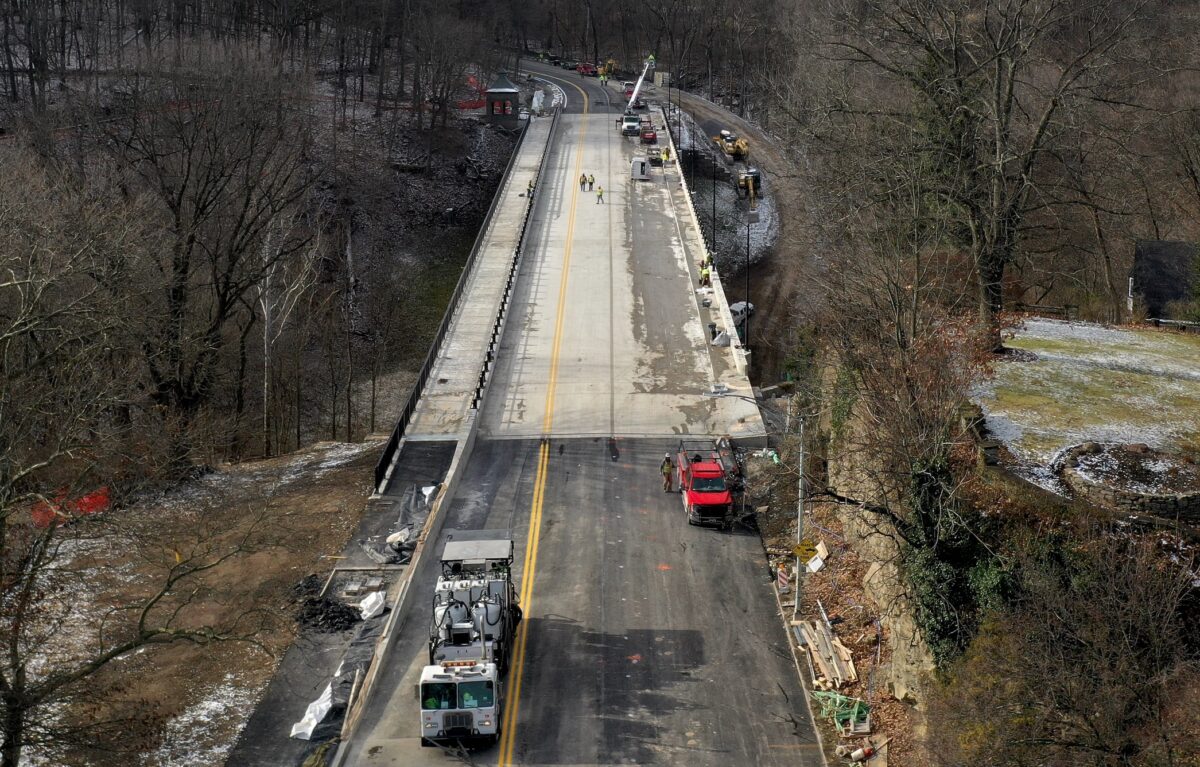A year ago today, the Fern Hollow Bridge between Pittsburgh’s Squirrel Hill and Point Breeze neighborhoods collapsed off Forbes Avenue into Frick Park below, injuring 10 people and interrupting a daily road connection for 14,000 motorists and dozens of residents and businesses.
Today, in record time, the bridge has been partially reopened. But issues remain: finishing construction and aesthetic improvements, restoring the park, another closure of at least a week next summer to treat the bridge surface, lawsuits from those injured, and determining what caused the 447-foot bridge to crash into the ravine that snowy winter morning.
Bridge ‘coming along’
Cheryl Moon-Sirianni, district executive for the Pennsylvania Department of Transportation whose office is overseeing the replacement, said it likely will be June or July when the bridge reaches its full capacity of two lanes of traffic in each direction with a narrow pedestrian lane on one side and a wider combination biking, running and walking lane on the other. Right now, there is one lane of traffic each way and a pedestrian path.
In addition to PennDOT finishing the bridge itself, the city plans in the spring to pave Forbes Avenue between South Dallas Avenue and the bridge on the Squirrel Hill side. The access road that contractors created from the Squirrel Hill side down to the park will be improved to become a pedestrian trail.
Besides winter weather, another element impeding the remaining work is a delay in obtaining the traffic signal that will be installed midblock between the bridge and South Braddock. That wasn’t added to the project until midsummer, and its delivery is being delayed by supply-chain issues, Moon-Sirianni said.
Also in the spring, crews can begin work to replace the mud and dirt that resulted from construction with grass, trees and other vegetation. It probably will take more than one season to restore the area’s natural habitat.
Even before the start of construction, critics spoke out about the plain, lackluster design of the bridge, which mostly resulted from the need to rebuild quickly with the easiest-to-obtain materials.
To remedy that, the city’s Office for Public Art has selected two artists, John Pena and Carin Mincemoyer, to develop public art around the bridge. Additionally, support columns will be stained to improve their appearance.
Moon-Sirianni said the final budget for that aesthetic work hasn’t been set yet because construction is continuing and officials don’t know how much of the emergency $25.3 million federal grant will be available.
And even when the four lanes are completed, motorists will have to endure another closure some time next summer. Moon-Sirianni said the bridge will be closed for at least a week for crews to apply a special epoxy-like substance to the bridge surface that should add more than 10 years to its life expectancy. That procedure only can be done in warm weather, which helps the substance to cure.
“We do this kind of application on almost all of our new bridge surfaces,” Moon-Sirianni said. “This has always been the intention to have a summer closure to do this.”
PennDOT managed the reconstruction because of its experience with emergency projects, but the bridge will be owned and maintained by the city.
Moon-Sirianni said the question she has heard most often since Fern Hollow reopened in late December is why can’t all projects be completed so quickly. Her answer is easy: Not every project is an emergency, which moves supplies and other needs for a project to the top of the list. If every project were treated as an emergency, they all would face the same delays because none of them would get special treatment.
“What people don’t understand is when there is an emergency, everything for that project goes to the top of the list,” she said. “That just can’t happen with every project.”
Legal claims
The old bridge’s long-term deterioration — it had been rated in poor condition since 2010 with only minor upgrades — has spawned many of those injured in the collapse to file legal claims against the city.
The latest were filed this week on behalf of two couples by attorneys C.J. Engler and Paul Ellis. The suits claim that despite repeated inspection reports about problems with the bridge the city “failed to adequately address the needed repairs and maintenance on the bridge,” leading to the collapse.
Velva and Tyrone Perry claim they each had broken bones in their backs after the truck he was driving across the bridge fell into the park. Thomas Bench claims he had a severe back and neck sprain as well as continuing shoulder pain after his vehicle went down with the bridge, and his wife, Sara, claims loss of consortium from his injuries.
The city doesn’t respond to pending litigation.
In a statement, the attorneys said, “The collapse of the Fern Hollow bridge, while tragic, was completely preventable. Our lawsuit is designed to prioritize and address the devastating injuries and permanent impact upon the innocent victims and their families, and implement policy measures to protect our fellow citizens.”
NTSB investigation
The National Transportation Safety Board is continuing its investigation into the exact cause of collapse of the Fern Hollow Bridge. The agency released 1,797 pages of technical documents Thursday, but none of the material included analysis about the cause.
A preliminary report in May said the agency is examining video taken from a Pittsburgh Regional Transit bus that was on the bridge when the incident occurred about 6:40 a.m. The bus was traveling from Squirrel Hill to Point Breeze when the section of pavement in front of it broke away from an expansion joint and at almost exactly the same time the deck broke away from the west abutment behind the bus, causing the bridge to fold into the ravine.
Other experts who have reviewed inspection reports and photos of the debris from the bridge have centered on temporary repairs made on one set of severely deteriorated bridge supports, which were held together by steel cables strung between them. The NTSB said in its preliminary report that it hadn’t found any critical fractural points in the wreckage.
When the agency finishes its investigation, it is expected to hold a hearing in Pittsburgh where a series of investigators will present their findings and make recommendations for avoiding similar incidents in the future.
Ed covers transportation at the Pittsburgh Post-Gazette, but he's currently on strike. Email him at eblazina@unionprogress.com.



